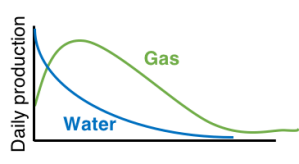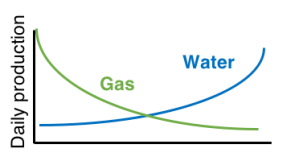
I am writing this to give a bit of information about the two “creatures” called CBM and Conventional Gas, before I get into my PhD research. This is a little bit technical, but just to remind you, that I am not a geologist nor a petroleum engineer nor geophysicist. So, i am going to explain about these two creatures with my way of understanding, and I do really hope that you will understand the difference between two of them.
What is exactly CBM? CBM is Coal Bed Methane – betty that is the abbreviation! – yeah that is exactly what CBM is! It is a Gas (methane) that is trapped in a coal! That is why we call it Coal Bed Methane (CBM). What is the difference with the conventional gas? That is good question! the conventional gas here is the gas that is trapped in a fault! Honestly, I didn’t understand as well before I started my research proposal!
In fact, the CBM is one of the unconventional type of gas. The other example is shale gas. I am not gonna discuss about this just yet. Will do it next time! Yes so CBM is unconventional gas. Why is it unconventional? Because, it needs an “advanced” production method to get them out of the earth! Wait, so that means that the conventional gas does not need this advanced production method? The conventional gas is produced by drilling its well vertically. And for CBM, you need to have two separates pipe for water production and the gas production! You need to do fracking with the CBM, and inject the water into the well to create a different pressure that can make the gas flow to the production well!

http://www.lawmerallarm.org/media/natural-gas-basics
Now, let us see where they are actually located. CBM is not as deep as conventional gas. CBM can be located in 500 – 1500 feet deep down under the ground. This is equivalent to 150 – 500meters (more or less). How deep is the conventional well then? Hmm.. it could be 4000 – 12000 feet down there! It s like 1.2 -3.7 kilometres !
To see more clear, see the picture below:

(Flores, 2014)
See? The CBM is actually just almost on the surface 😀 And conventional gas is down there.
Next, the volume of the production. Do you know how much one CBM well can produce? It is not a big volume though and even worse, the volume produce is just fluctuating. The volume can be as small as 50mcfd and as high as 5mmcfd. What about the conventional? Hohoho, that one conventional well can actually produce as high as 1bcfd!!! and even if it is not that much, you might get as small as 300mmcfd for one well! See how much difference that volumes are?
Think of the project economy! The CBM is not economically viable with only one well being developed! There is no chance for you to make the project economically viable! The volume is fluctuating, and it is not a huge amount of volume!!! You need to drill more than 100 wells to make your project economically viable. For example the Australian CBM, they drilled at least 322 CBM wells from 2000-2006 (Australian Government, 2016). Of course with hundreds of wells being developed, this requires large area to do the project. Unlike CBM, conventional gas can be economically viable only with one well developed!
How long do you think the production life of a CBM well? Guess.. The conventional gas well can have over than 50 years production life. What about CBM? Unfortunately, it is only 5 -15 years, and you need to be lucky enough to have more than 15 years!
Let’s look at the production cycle below:


CBM production cycle Conventional gas production cycle
(ALL Consulting and Montana Board of Oil and Gas Conservation, 2004; EIA, 2017)
Look at the difference. Yes, CBM produces water sooo much at the initial production stages, but it decreases following the increasing of the gas production. Then after the peak production, they both decreases til end of their life 😀
The conventional gas production life cycle is just different than CBM. The gas produced at the beginning is high, but then it starts to decline after the first production. On the contrary, small volume water at the initial gas production, and gradually increases following the decrease of the gas production.
Now, let me summarise for all the explanation above.
| Items | CBM | Conventional |
| Depth (feet) | 400-1500 (shallow) | 4000 – 12000 (deep) |
| Where? | trapped in a coal | trapped in a fault |
| Volume per well | Fluctuate & Low volume 50 MCFD and high volume 5MMCFD | Consistent & low volume 300MMCFD and high volume can reach 1BCFD |
| Economic viability – number of wells drilled | Hundreds | one |
| Production Life | 5-15 years | Can be over than 50 years |
Production Life Cycle


Well, this is the end of the explanation about the two amazing creatures LOL. I hope you find this information easy to understand and give you benefits!
REFERENCES
- ALL Consulting group http://www.all-llc.com/publicdownloads/CBMPRIMERFINAL.pdf
- Flores, R. (2014). Coal and Coal Bed Gas: Fueling the Future. United States of America: Elsevier Inc., pp.567-574.
- Ga.gov.au. (2016). Table 1: Number of Coalbed Methane Wells Drilled 2000-2006 – Geoscience Australia. [online] Available at: http://www.ga.gov.au/data-pubs/data-and-publications-search/publications/oil-gas-resources-australia/2006/coalbed-methane/table-1 [Accessed 15 Nov. 2016].


